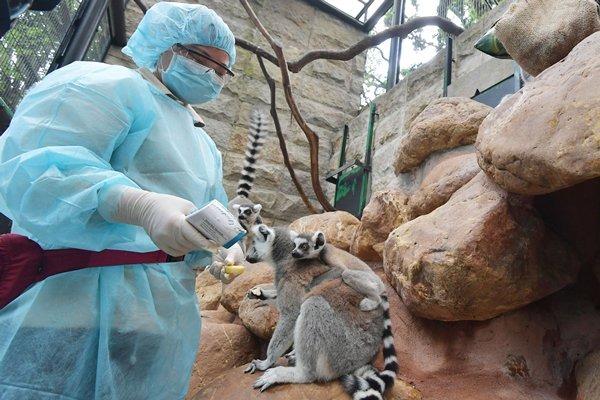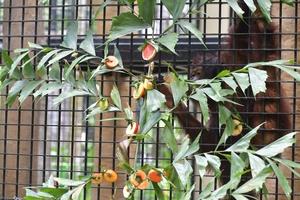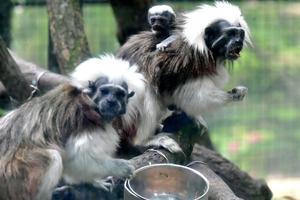
In this undated photo, a staff member of the Zoological & Botanical Gardens wears full protective gear each time they enter the mammal's enclosures and closely monitor their health. (PHOTO / HKSAR GOVT)
The Siamangs or black-furred gibbons and their famous friends the Bornean Orang-utan twins have not seen many curious visitors around their enclosure for a while.
Their home at the mammal section of Hong Kong's Zoological & Botanical Gardens has been temporarily closed due to the pandemic.
Stringent anti-pandemic measures have been implemented at the gardens to protect the health of the animals living there
Playful tricks
Despite the lack of visitors, staff ensured the playful primates were kept busy.
To keep the animals active, the zookeepers incorporated a variety of training techniques, such as tying fruit to tree trunks to motivate them to climb and move around the enclosure.
ALSO READ: CE vows to expand community testing to curb COVID-19
“We make food balls to encourage them to use their fingers to take the food. This ensures they frequently use their fingers and stimulates their brain, since they have to figure out how to get the food,” Leisure & Cultural Services Department Senior Amenities Assistant Cheung Wai-lam explained.
Reducing risk
The animals not only stayed active but continued to grow healthy during the epidemic with the help of their caretakers.

This undated photo shows the fruits that zookeepers tied to tree trunks to encourage the primates to climb and move around the enclosure. (PHOTO / HKSAR GOVT)
Stringent anti-pandemic measures have been implemented at the gardens to protect the health of the animals living there.
On Friday, the Centre for Health Protection of the Department of Health announced 57 additional confirmed COVID-19 cases, bringing the city’s tally of confirmed cases to 8,481. A total of 1 133 cases have been recorded between December 11 and 24, including 1,047 local cases of which the origin of 400 couldn't be ascertained.
Staff must wear full protective gear, such as gowns and face masks, as well as disinfect their footwear each time they enter the mammal enclosures.
Cheung noted that the mammals get their temperatures checked and their health is closely monitored.
ALSO READ: HK sees 71 new virus cases as experts monitor S. African strain
“The animals’ eyes, ears, mouth and nose are checked to see if they have a runny nose or tears. We will also assess the flexibility of their arms and legs and if they have any wounds. We look at if they are breathing fast which could mean they are nervous. Also, their coats should be bright and waterproof to indicate that they are healthy.”
Breeding season
The mammal families at the gardens expanded during the epidemic.
The Buff-cheeked Gibbons, Ring-tailed Lemurs, White-faced Sakis, Black & White Ruffed Lemurs and Cotton-top Tamarins all welcomed new additions to the family.
Cheung said the birth of a Cotton-top Tamarin in May was particularly special.

The mammal families at the gardens expanded during the pandemic, including the Cotton-top Tamarins which welcomed a new addition in May. (PHOTO / HKSAR GOVT)
“We are very happy about the birth as the Cotton-top Tamarin is an endangered species. They are not only bred overseas. Now we have one born in Hong Kong. We provide them with protein-rich foods and grow their favourite plants to create a good environment for them to breed.”
READ MORE: World's rarest primate grabs a survival lifeline in jungle
The Zoological & Botanical Gardens enhanced cleaning and disinfection of the mammal enclosures during the epidemic.
During these days when seeing the primates is not possible, the public may learn more about their characteristics and behaviour through the Leisure & Cultural Services Department’s online platform Edutainment Channel and get prepared for future visits.


